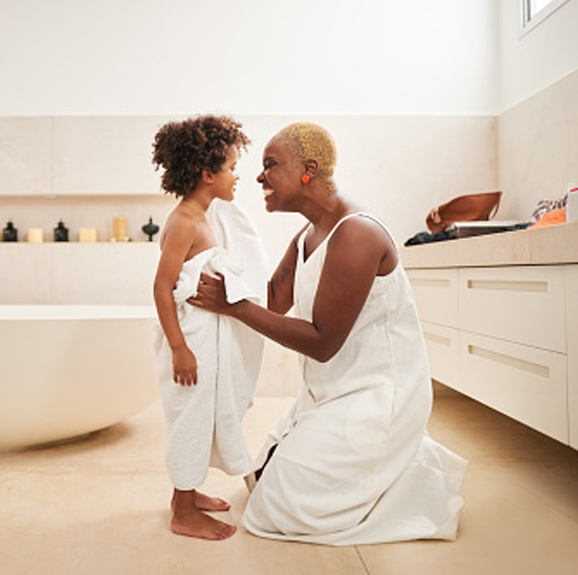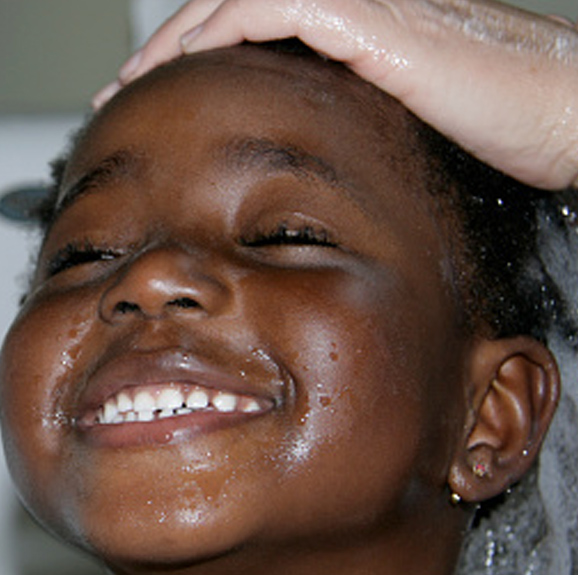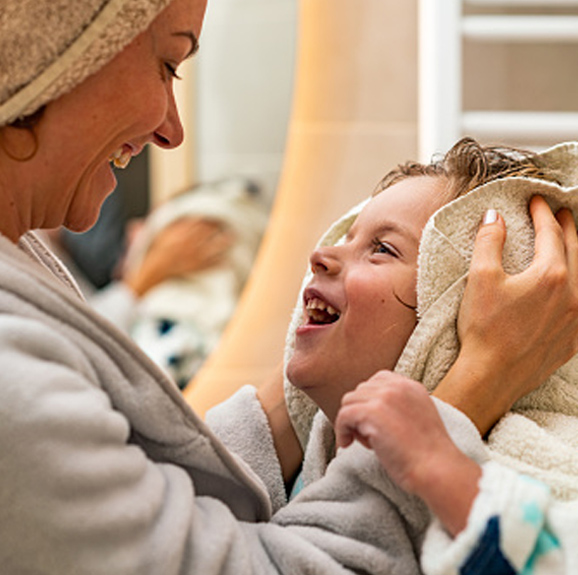Whether you have a baby with a head as soft as silk or a teenager whose hair hasn’t seen a bottle of shampoo or brush for months, we understand there will be times when some common hair care challenges rear their ugly heads (excuse the pun) from birth, right up until puberty hits. But fear not, we can guide you through the pitfalls with our straightforward advice. Please note that Vosene Kids products are not suitable for babies and newborns.
BIRTH TO 3 YEARS OLD
From the day your little cherub is born, right up until the arrival of the toddler years, hair doesn’t really do an awful lot. Some babies are born with a thick curly mane, others merely have a wisp that will stay that way until they are two or three.
And whilst it can sometimes be tricky to keep them looking clean and tidy as they bomb around getting grubby, the good news is that at this age, winning the hair care battle is much easier than in later life.

How do I care for hair in the first few years?
For babies with little or no hair, simply rinse the scalp at bath time. For little ones with a more substantial mane, wash every two to three days with a gentle cleansing shampoo.
Always check the scalp for answers to your baby’s hair health – if you spot signs of dryness or cradle cap, be sure to treat it accordingly. If your toddler is averse to having their hair washed and is likely to go into meltdown at the mere sight of running water, let them bring a toy into the bath and play with it while you get to work on their hair – distraction techniques are key here and will help with any stressful bath time battles. Introduce a regular hair care routine at an early age and this should set them up for life. Here’s hoping!
Hair checklist Birth to 3 years old:
- Don’t wash hair too often – every two to three days is fine
- Always use a gentle, tear-free shampoo on young hair
- Check the scalp regularly for signs of cradle cap
- Establish a regular routine: get little ones used to having their hair washed
4 TO 8 YEARS OLD
As children keep growing, so does their hair, and it’s likely that you’ll see quite a change in their locks during this period. When they start school or nursery and become more mobile and independent, they’ll also become more prone to unwanted visitors taking up camp in the hair.
This is when you’ll probably want to start incorporating regular ‘wet combing’ and nit checks into your bath time routine to avoid nasties taking over. No doubt, our Vosene Kids range with lice repellents will be a welcome addition to your household at this stage. Using our Vosene Kids 3in1 Shampoo and Conditioning Defence Spray will ensure your little ones have clean and conditioned hair. And the natural ingredients in the products – tea tree oil, lemon eucalyptus and citronella – are great at helping keep head lice at bay.
Healthy, happy children are more likely to have healthy-looking, happy hair. This means feeding them a varied, well-balanced diet, making sure they drink lots of water, get plenty of sleep and follow an effective hair care routine. If you stick to these basics, you’ll be well on your way to helping them achieve lovely locks.

What hair care products and accessories are essential for young hair?
Each child’s hair is different: long, short, curly, straight, dry or oily. But whatever their hair type, it’s certainly worth thinking about investing in some products and accessories that will help care for hair and bring some much-needed calm to bath time.
It’s very easy to feel bamboozled by the vast array of products out there, but stick to some simple rules when it comes to choosing products for your little one’s locks and you’ll be laughing all the way to the bathroom:
- Choose gentle, lightweight products that moisturise and detangle the hair without weighing it down and making it look dull
- Invest in a good brush and wide-toothed comb – a paddle brush is perfect for combatting tangles
- Chlorine damages the hair, so always use an effective after swim product, which zaps chlorine and other impurities
Hair checklist 4 to 8 years-old:
- Have regular trims – this will keep hair healthy-looking and tangle-free
- Keep critters at bay with ‘wet combing’ and regular nit checks –don’t forget the Vosene Kids products with lice repellents as they will help you in your quest for nit-free hair
- Encourage more independence in the bath – let them slather on the conditioner and comb their hair
- Wash hair more regularly as it gets longer and thicker
9 YEARS OLD AND UPWARDS
By nine years old your child will, no doubt, think they know it all. They will be much more independent and freethinking, and the days of you bathing them may well be long gone. Add to that the fact that the awkward, uncomfortable years of puberty are just around the corner and you could have a battle on your hands. The innocent, angelic little cherubs you raised with all your heart and soul turn into sultry, moody human beings with no time for annoying grown-ups.
Some teens will sing all the way to the shower and suddenly develop a newfound interest in grooming, others will need some serious bribery to even think about having a wash. It’s easy to understand why all these changes can be embarrassing for youngsters making their first foray into adulthood but remind them that you have first-hand experience and can help them. Mission Teenager is easier said than done and things may not necessarily go to plan, but that doesn’t mean you can’t try.

How can I (subtly) help my teenager follow a healthy hair care routine?
First things first, buy them a pH neutral shampoo that’s specially formulated for their hair type. Try to make sure they are following a healthy hair care routine, not washing hair too often, and not leaving it until it walks to the bathroom by itself.
Hydrating, moisturising and gentle are all words to look out for on packaging when buying hair products, as these will offer the most protection in older hair. If your teen is partial to using hair straighteners, try to suggest they use them less frequently as they cause heat damage and split hairs.
As hair goes through drastic changes during puberty, it’s a good idea to get it cut regularly. Always use products that suit your child’s specific hair type and follow shampooing with a healthy dollop of conditioner. Don’t put conditioner directly onto the scalp (just use it on the ends) as this can make oily hair worse. They might not admit it, but your little adults will be grateful for the guidance.
Hair checklist 9 years old and upwards:
- Buy hair products that suit your child’s specific hair type – this will avoid stripping it of essential oils and minerals
- Avoid blow-drying and regular use of hair straighteners as this damages the ends and causes hair to split
- Always condition the tips of the hair after shampooing to encourage silky smooth, tangle-free locks
- Invest in regular trims – the best way to keep hair strong and healthy-looking
Article written using the following sources:
WebMD, Baby Maintenance: Baths, Nails, and Hair, December 2020
NHS Greater Glasgow and Clyde, Hair Washing and Styling, 2017
American Academy of Dermatology Association, Teaching your child healthy hair care habits, 2021
